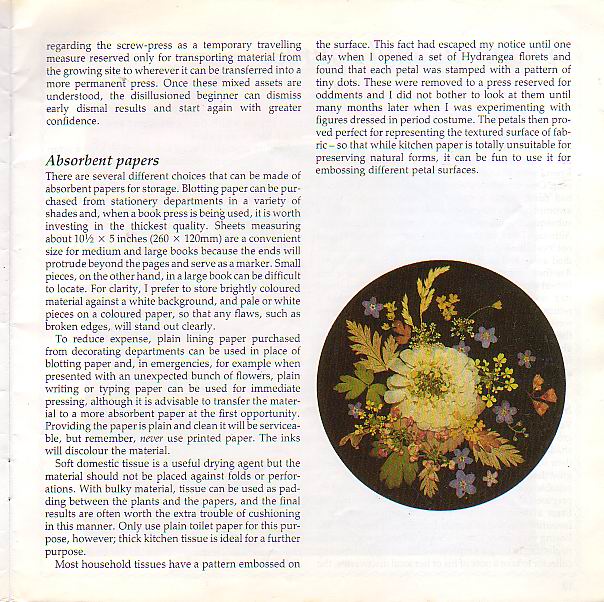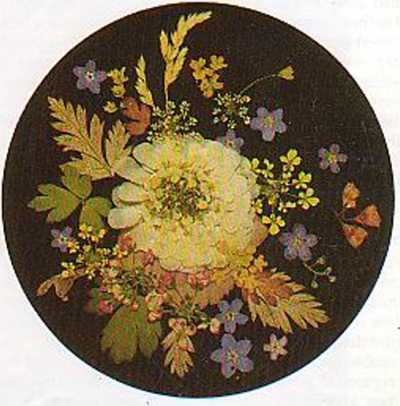749849337958684480

regarding the screw-press as a tempnrary travelling measure reserveri onlv for transporting materiał from the growing site to wherevcr it can be transferred into a morę permancnt piCSS. Once these mixed assets are understood, the disillusioned begirutcr can dismiss early dismai results and start again with grenter confidence.
Absorbent papers
There are seeeral different choices that can be madę of absorbent papers for storage. Blotting paper can be nur-cha sod from stationery departments in a variety of shades and. whenabook pressis being used, il is worth invesling in the thickest quality. Sheets measuring aboutlOtó X 5 inches (2fi0 x 120mm) are a convenicnt sizc for medium and large bcoks because the end; will protrude beyond the pagcs and serve as a marker. Smali picees, on Ihe olher hand, in a large hook can be difficult to locate. For darity, 1 prefer to storę brightly colourcd materiał against a wbite background, and pale orwhite pieces on a coloureri paper, so that any flaws, such as broken cdgcs, will stand out dearly.
To reduce expense, plain lining paper purchased from decorating deparlments can he used in płace of blotting paper and, in emergcncies, for cxamplc when presented with an unexpecled bunch of flowers, plain wriring nr typing paper can be used for immediate pressing, although it is advisable (o transfer the materiał to a morę absorbent paper a: the first opportunity. Proeiding the paper i$ plain and dean it will be servicea-ble, but remember. never use printed paper. The inks will discolour the materia!.
Soft domestic tissue is a useful drying agent bul the materia! shouid not be placed against lolds or perfor-ations. With bulky materiał, tissue can be used as pad-ding between the plants and the papers, and the finał results are often worth the extra irouble of cushiuning in tliis manner. Only use plain toilet paper for this pur-pose, htnvever; thick kitchen tissue is idea! fora further purpose.
Most household lissues have a patiem embossed on the surfacc. This lact had escaped my notkę unii] one day when I opened a se: of Hydrangea flnrets and found that each petal was stamped with a partem of tiny dots. These were rernoved to a press rescrved lor oddinents and I did not hotber to look a: them until many months Jater when I was experimenting wilii figures dressed in period costume. The petals then pro-ved perfcct for representing the textured surfaco of fa'o-ric so that while kitchen paper is totally unsuitable for presemng natura] forma, it can be run to use it for enibossing different petal surfares.

Wyszukiwarka
Podobne podstrony:
regarding the screw-press as a tempnrary tnwelling measure reserved only for tiansporting materiał f
pociąg sekwencje NAME:_DRAW CARGO IN THE SAME SEOUENCE AS IN BEGINNING. set: preschool fun for morę
IMGr3 Ernst Much parcntly, regardlcss of how far away an object was, łic “saw” it as the same sizc a
14 I believe both thc Gyrinini and the Orecłochilini to be while I regard the Enhydrini as an certai
52 (224) 98 The Viking Age in Denmark wali is of about the same size as the one at Aggersborg, measu
Air transportation problems regarding the MS-40 bridge 199 The spans (folded) must be transported as
Licentious tongues: The court eunuch in European travelogues The eunuchs of the Mughal court, often
page16 (5) Top Catchos As o further sofely measure the top locking catches of the VW Con-vertible an
P5140045 Measure a strip of 3" wide Kinesio Tape approj. mately the same length as used in the
image006 !n thls my elghty-third year of llfe, do hereby declare the followlng statcments as my
image038 a Fig 10 Idea of the “World tree" as the “World axis" implemented m settlements o
00076 M7835e1b40748c3da0ef62db71aede2 75 Adaptive Hierarchical Bayesian Kalman Filtering estimates
00165 ?010d5404608203a3dae9f6c233f640 166McWilliams specify constraints regarding the time during w
więcej podobnych podstron